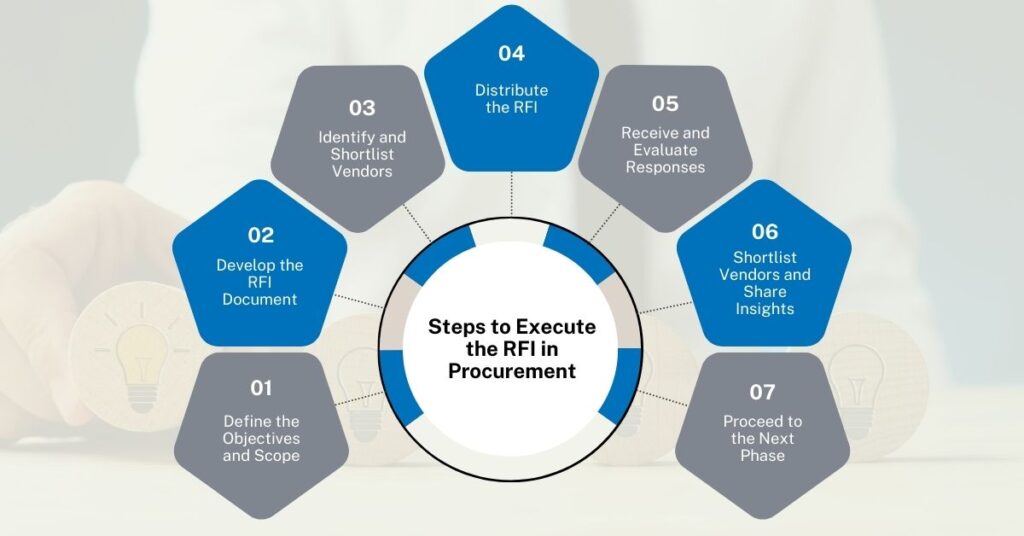
Do you ever feel overwhelmed and anxious about the large number of suppliers? Do you feel stressed while making a vital procurement decision? If yes, you are not alone. The process of dealing with procurement could be an overwhelming experience. Particularly when finding the right match for your organization’s unique needs. This is precisely where an RFI in procurement comes into the picture.
Request for Information helps you cut through the chaos and clarify the procurement process. An Institute of Supply Management survey found that 43% of organizations use RFIs to gather information on products or services.
RFI helps you to gather valuable insights about:
- Potential suppliers
- Supplier capabilities and
- Alignment with your goals
When you have the right RFI, you make better and smarter decisions. Not only that, you also save a lot of time and money in the procurement process. This blog will help you understand what RFI is, its components, processes, and much more.
What is an RFI in Procurement?
RFI, or Request for Information, is a formal document where organizations gather detailed information from suppliers during procurement. The information here includes everything about the potential suppliers, their products, and solutions before beginning the procurement process. It is one of the initial stages to understand the capabilities, experience, and offerings of vendors in the market.
The RFI helps the procurement team rectify their needs, find suitable suppliers, and understand if a vendor can meet their expectations. Ideally, the RFI includes a document with a structured questionnaire about the vendor’s experience, services, costs, and operational practices.
With such detailed information, organizations can make informed decisions whether to go ahead with the RFP (Request for Proposal) or RFQ (Request for Quotation). This helps minimize the risks and ensures compliance with organizational goals. RFI in procurement also streamlines the process and paves the way to achieve goals and success.
Download the free RFP template here
The Importance of RFI in Procurement
The RFP procurement process is important for decision-makers to stay informed and streamline the procurement process. Hence, RFI is very important and are the reasons why:
- Market Insight: RFI provides organizations with a way to learn about the various vendors’ products and services. This offers an opportunity for assessing options effectively this way.
- Requirement Clarification: The RFI procurement process lets businesses recognize better what they need. It defines correctly the project scopes for best alignment with organizational objectives.
- Supplier Shortlisting: After understanding the responses, the procurement teams can choose the best suppliers. Once this is done, they can streamline the process for the next one such as RFP or RFQ.
- Risk Management: RFI in procurement helps minimize risks. It helps companies like yours assess the vendor’s capabilities, history, and compliance before signing the contract.
- Cost and Time Efficiency: By gaining in-depth insights from RFIs, your organization can save time, money, and resources. You can focus on those vendors who help you meet your organizational goals.
The RFI procurement process is thus a vital tool for strategic procurement planning and achieving optimal outcomes.
You May Also Like: RFP for Travel Management Services: A Complete Guide
Calculate your savings now!
Components of an RFI in Procurement
1. Introduction and Purpose
This section introduces the goal of the RFI documents. It mainly includes gathering vendor information or finding out new options. It generally includes a main overview of your organization and the supplier of their solutions.
2. Scope of Requirements
This section of the RFI in procurement comprises information regarding the scope of the work. These mainly include goals, timelines, and deliverables. Before beginning, the vendors get clarity on what is required of them and work accordingly.
3. Vendor Information
The vendor sections in the RFI include complete information about the vendors. It includes details such as:
- When the company was founded
- Existing clients
- Their expertise
- Services they provide
These details help you to assess their work and contribution to the procurement process.
4. Pricing
This procurement section includes all the pricing information provided by the vendor. Pricing will give you a rough estimate of what services suit your business.
5. Compliance and Certifications
Vendors usually have to comply with specific standards and regulatory requirements. This section will include details about their practices and whether they comply with industry requirements and sustainable processes.
6. Response Format and Guidelines
This section includes detailed information for submitting an RFI. Everything about deadlines, format, and contact details is mentioned here.

7 Steps to Execute the RFI in Procurement
1. Define the Objectives and Scope
- First, identify the purpose of the RFI. You must explore different capabilities in the market, evaluate the potential suppliers, and then shortlist the options for an RFP or RFQ.
- After this is done, identify your requirements. This can be either functional, technical, or operational services. This will help vendors understand your expectations.
2. Develop the RFI Document
- Prepare a detailed RFI document that contains everything you are looking for. This section includes an introduction, project overview, vendor information, services, and deadlines.
- Explain everything in simple language and include the correct information to avoid any confusion.
3. Identify and Shortlist Vendors
- To identify the potential and best vendors, you must do thorough market research. Identifying the best vendors who have the expertise and capabilities to meet your goals is important.
- Based on your research, shortlist vendors that are reputed and have great delivery services.
4. Distribute the RFI
- Once the RFI is drafted, distribute it to the potential vendors and on a timely basis. Distribute it through email, a procurement portal, or another established communication channel.
- Always be available to clarify any doubts or provide any additional information during the procurement process. Vendors may have questions regarding the RFI’s content or your organization’s expectations.
5. Receive and Evaluate Responses
- After distribution, ensure that all vendors submit their RFI in procurement to you before the deadline. Remind them verbally and send follow-up emails to ensure they submit their services on time.
- Once you receive them, assess their answers on criteria such as functions, operations compliance, operations, etc. You can create a scoring card and objectives that you can tick off if they have met your expectations.
6. Shortlist Vendors and Share Insights
- Once you have received the responses, shortlist the vendors whom you feel are suitable for your procurement process. If certain vendors meet your expectations, then delve deeper to evaluate them.
- Prepare a detailed report and present it to your stakeholders. Share the benefits of these vendors and their important contributions. The report can include parameters such as cost savings, unique offerings, or any potential risks.
7. Proceed to the Next Phase
- Depending on the insights gained, proceed to the Request for Proposal (RFP), Request for Quotation (RFQ), or direct negotiations.
- Use an RFP if you need more detailed proposals. This is very ideal if you wish to know how the vendor will meet your requirements. Go ahead with an RFQ if you feel they meet your standards and expectations.
Unlock Strategic Benefits with RFI in Procurement
The RFI in procurement is one of the essential approaches to the procurement process. It provides organizations like yours with a structured approach to understanding the market. You also will be able to assess the potential suppliers and their capabilities. By following the right steps, you can streamline your RFI procurement process.
If your organization is into business travel and looking to make your RFP process easy, look no further than itilite. It is one of the leading travel management companies specializing in travel and expense. We have a unified travel platform and a large travel inventory sourced directly from the GDS. Moreover, we also provide round-the-clock travel support and in-depth insights.
If you wish to know how we can be a strong support in your RFP process, connect with us now!







